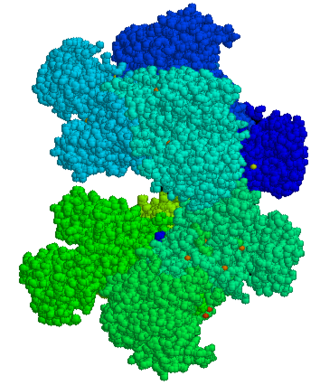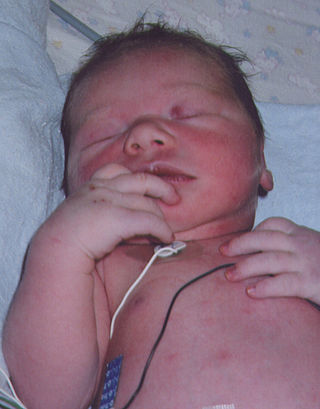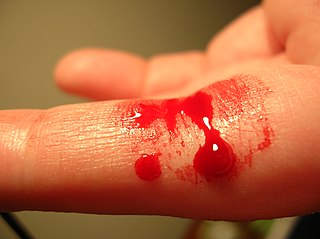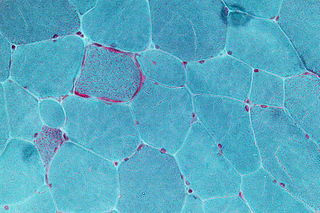Related Research Articles

Eosinophilia is a condition in which the eosinophil count in the peripheral blood exceeds 5×108/L (500/μL). Hypereosinophilia is an elevation in an individual's circulating blood eosinophil count above 1.5 × 109/L (i.e. 1,500/μL). The hypereosinophilic syndrome is a sustained elevation in this count above 1.5 × 109/L (i.e. 1,500/μL) that is also associated with evidence of eosinophil-based tissue injury.

Methemoglobinemia, or methaemoglobinaemia, is a condition of elevated methemoglobin in the blood. Symptoms may include headache, dizziness, shortness of breath, nausea, poor muscle coordination, and blue-colored skin (cyanosis). Complications may include seizures and heart arrhythmias.

Glucose-6-phosphate dehydrogenase deficiency (G6PDD), also known as favism, is the most common enzyme deficiency anemia worldwide. It is an inborn error of metabolism that predisposes to red blood cell breakdown. Most of the time, those who are affected have no symptoms. Following a specific trigger, symptoms such as yellowish skin, dark urine, shortness of breath, and feeling tired may develop. Complications can include anemia and newborn jaundice. Some people never have symptoms.

Porphyria cutanea tarda is the most common subtype of porphyria. The disease is named because it is a porphyria that often presents with skin manifestations later in life. The disorder results from low levels of the enzyme responsible for the fifth step in heme production. Heme is a vital molecule for all of the body's organs. It is a component of hemoglobin, the molecule that carries oxygen in the blood.

Blue baby syndrome can refer to conditions that cause cyanosis, or blueness of the skin, in babies as a result of low oxygen levels in the blood. This term has traditionally been applied to cyanosis as a result of:.
- Cyanotic heart disease, which is a category of congenital heart defect that results in low levels of oxygen in the blood. This can be caused by either reduced blood flow to the lungs or mixing of oxygenated and deoxygenated blood.
- Methemoglobinemia, which is a disease defined by high levels of methemoglobin in the blood. Increased levels of methemoglobin prevent oxygen from being released into the tissues and result in hypoxemia.

In medicine (hematology), bleeding diathesis is an unusual susceptibility to bleed (hemorrhage) mostly due to hypocoagulability, in turn caused by a coagulopathy. Therefore, this may result in the reduction of platelets being produced and leads to excessive bleeding. Several types of coagulopathy are distinguished, ranging from mild to lethal. Coagulopathy can be caused by thinning of the skin, such that the skin is weakened and is bruised easily and frequently without any trauma or injury to the body. Also, coagulopathy can be contributed by impaired wound healing or impaired clot formation.

Methemoglobin (British: methaemoglobin, shortened MetHb) (pronounced "met-hemoglobin") is a hemoglobin in the form of metalloprotein, in which the iron in the heme group is in the Fe3+ (ferric) state, not the Fe2+ (ferrous) of normal hemoglobin. Sometimes, it is also referred to as ferrihemoglobin. Methemoglobin cannot bind oxygen, which means it cannot carry oxygen to tissues. It is bluish chocolate-brown in color. In human blood a trace amount of methemoglobin is normally produced spontaneously, but when present in excess the blood becomes abnormally dark bluish brown. The NADH-dependent enzyme methemoglobin reductase (a type of diaphorase) is responsible for converting methemoglobin back to hemoglobin.

X-linked recessive inheritance is a mode of inheritance in which a mutation in a gene on the X chromosome causes the phenotype to be always expressed in males and in females who are homozygous for the gene mutation, see zygosity. Females with one copy of the mutated gene are carriers.

A metabolic disorder is a disorder that negatively alters the body's processing and distribution of macronutrients, such as proteins, fats, and carbohydrates. Metabolic disorders can happen when abnormal chemical reactions in the body alter the normal metabolic process. It can also be defined as inherited single gene anomaly, most of which are autosomal recessive.

Biotinidase deficiency is an autosomal recessive metabolic disorder in which biotin is not released from proteins in the diet during digestion or from normal protein turnover in the cell. This situation results in biotin deficiency.

Factor VII deficiency is a bleeding disorder characterized by a lack in the production of Factor VII (FVII) (proconvertin), a protein that causes blood to clot in the coagulation cascade. After a trauma factor VII initiates the process of coagulation in conjunction with tissue factor in the extrinsic pathway.
Fumarase deficiency is an exceedingly rare autosomal recessive metabolic disorder in the Krebs cycle, characterized by a deficiency of the enzyme fumarate hydratase, which causes a buildup of fumaric acid in the urine and a deficiency of malate. Only 13 cases were known worldwide in 1990, after which a cluster of 20 cases was documented in a community in Arizona, US that has practiced successive endogamy.
Blue people may refer to:

Prolidase deficiency (PD) is an extremely uncommon autosomal recessive disorder associated with collagen metabolism that affects connective tissues and thus a diverse array of organ systems more broadly, though it is extremely inconsistent in its expression.

NADH-cytochrome b5 reductase 3 is an enzyme that in humans is encoded by the CYB5R3 gene.

Fibrinogen deficiency, also known as factor I deficiency, is a rare inherited bleeding disorder related to fibrinogen function in the coagulation cascade. It is typically subclassified into four distinct fibrinogen disorders: afibrinogenemia, hypofibrinogenemia, dysfibrinogenemia, and hypodysfibrinogenemia.

Troublesome Creek is a creek in Breathitt, Perry and Knott counties, Kentucky, a fork of the North Fork Kentucky River. It is 41.46 miles (66.72 km) long with a gradient of 8.92 feet per mile (168.9 cm/km), normally free-flowing, and with banks that vary between tree-lined and open.
GATA2 deficiency is a grouping of several disorders caused by common defect, namely, familial or sporadic inactivating mutations in one of the two parental GATA2 genes. Being the gene haploinsufficient, mutations that cause a reduction in the cellular levels of the gene's product, GATA2, are autosomal dominant. The GATA2 protein is a transcription factor critical for the embryonic development, maintenance, and functionality of blood-forming, lymphatic-forming, and other tissue-forming stem cells. In consequence of these mutations, cellular levels of GATA2 are deficient and individuals develop over time hematological, immunological, lymphatic, or other presentations that may begin as apparently benign abnormalities but commonly progress to severe organ failure, opportunistic infections, virus infection-induced cancers, the myelodysplastic syndrome, and/or leukemia. GATA2 deficiency is a life-threatening and precancerous condition.

The Book Woman of Troublesome Creek is a 2019 novel by Kim Michele Richardson. The story is a fictionalized account of real subjects in the history of eastern Kentucky. Cussy Mary is a "Book Woman" — one of the Packhorse Librarians who delivered books to remote areas of the Appalachian Mountains during the Great Depression, from 1935 to 1943, as part of President Franklin D. Roosevelt's Works Progress Administration (WPA) program. Cussy Mary is also a "Blue" — the last of a line of blue-skinned people, whose skin appears the unusual shade due to a rare genetic disorder. As a Book Woman, Cussy Mary is highly regarded, but as a Blue, she is feared and reviled, and experiences racism, discrimination and violence.
References
- ↑ "Blue-skinned family baffled science for 150 years". MSN. 24 February 2012. Archived from the original on January 22, 2013. Retrieved 10 May 2013.
- 1 2 Trost, Cathy (November 1982). "The Blue People of Troublesome Creek" (PDF). Science 82. Archived (PDF) from the original on September 27, 2015.
- ↑ Adams, Cecil (July 24, 1998). "Is there really a race of blue people?". The Straight Dope. Archived from the original on November 26, 2021. Retrieved April 22, 2021.
- ↑ "Rare disease turns mountaineers blue". Phoenix, Arizona: Arizona Republic. November 7, 1974. p. 12. Archived from the original on April 15, 2019. Retrieved April 3, 2019– via Newspapers.com.
- 1 2 3 James, Susan Donaldson (February 22, 2012). "Fugates of Kentucky: Skin Bluer than Lake Louise". ABC News . Archived from the original on March 18, 2012. Retrieved October 4, 2014.
- ↑ "Fugates of Kentucky: Skin Bluer than Lake Louise". ABC News . Archived from the original on March 18, 2012. Retrieved June 3, 2022.
- ↑ James, Susan Donaldson (March 8, 2012). "Blue People Look for Genetic Connection to Kentucky Fugates". ABC News . Archived from the original on October 17, 2014. Retrieved October 4, 2014.
- ↑ Davis, Lyle E. (January 19, 2006). "The Blue People of Troublesome Creek". The Paper. Archived from the original on July 19, 2019. Retrieved November 4, 2014.
- ↑ Cawein, M.; Behlen, Charles H.; Lappat, E. J.; Cohn, J. E. (1964). "Hereditary Diaphorase Deficiency and Methemoglobinemia". Archives of Internal Medicine . 113 (4): 578–85. doi:10.1001/archinte.1964.00280100086014. PMID 14109019.
- ↑ "God Bless Her Rotting Soul". Shameless. Season 8. Episode 3. November 19, 2017. Showtime.
You have a very rare chromosomal pattern, Mr. Ball. You are, more specifically, one in two billion. Were you aware you are from the Huntsville subgroup?